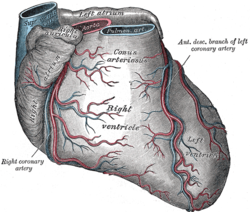Coronary sulcus
| Coronary sulcus | |
|---|---|
 | |
 | |
| Details | |
| Identifiers | |
| Latin | sulcus coronarius |
| TA98 | A12.1.00.011 |
| TA2 | 3945 |
| FMA | 7174 |
| Anatomical terminology | |
The coronary sulcus (also called coronary groove, auriculoventricular groove, atrioventricular groove, AV groove) is a
Structure
In relation to the rib cage, the coronary sulcus spans from the medial side of the 3rd left costal cartilage, to the middle of the right 6th costal cartilage.[1] Epicardial fat tends to be concentrated along the coronary sulcus.[4][5]
There are two coronary sulci in the heart, including left and right coronary sulci.
Left coronary sulcus
The left coronary sulcus originates posterior to the pulmonary trunk, and travels inferiorly separating the left atrium and left ventricle. The location of the left coronary sulcus is marked by the circumflex branch of left coronary artery, and coronary sinus.[6]
Right coronary sulcus
The right coronary sulcus begins anteriorly and superiorly on the sternocostal surface of the heart. Its position is marked by the location of the
Clinical significance
The left coronary sulcus is often neglected in echocardiography. As a result, normal variations and rare pathologic findings can be missed.[7]
See also
References
![]() This article incorporates text in the public domain from page 526 of the 20th edition of Gray's Anatomy (1918)
This article incorporates text in the public domain from page 526 of the 20th edition of Gray's Anatomy (1918)
- ^ S2CID 81803257, retrieved 2020-11-16
- ^ ISBN 978-0-12-380920-9, retrieved 2020-11-16
- ISBN 978-0-12-811908-2, retrieved 2020-11-16
- ISBN 978-0-323-52356-1, retrieved 2020-11-16
- ISBN 978-0-12-384885-7, retrieved 2020-11-16
- ISBN 978-0-12-812805-3, retrieved 2020-11-16
- PMID 9571589.
External links
- Anatomy photo:20:st-1101 at the SUNY Downstate Medical Center
- Diagram
